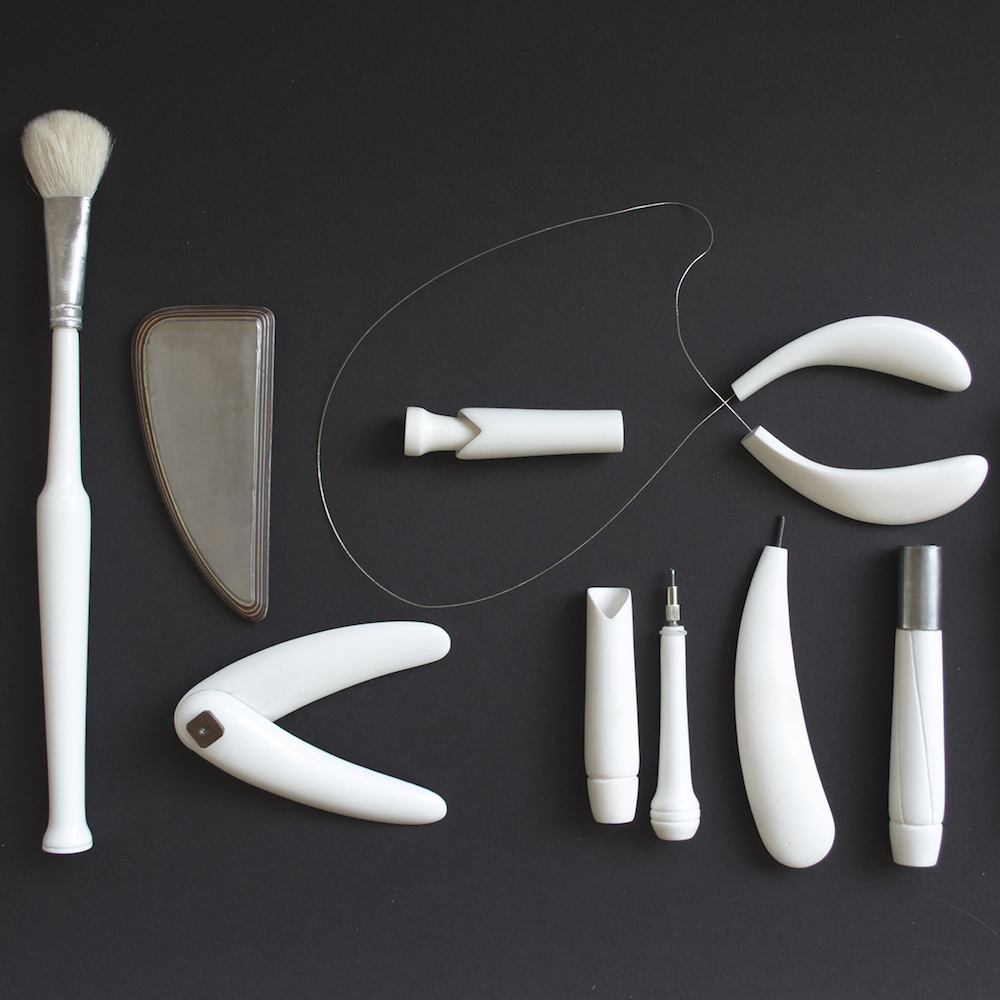Like a keel in seawater, they thrust things aside and clear a path for themselves. They work like a pair of hefty shoulders, easing others aside. Bit by bit they overthrow the opposition. As noiselessly as surgeons, they open a way through, not by demolishing but by leveling off, removing one foundation after another, subtracting supports. Scissors are specialists in deepening a crisis. They are creatures of evening. They’re cursed with a vindictive nature. And it’s not hard to see why. Each blade of a pair of scissors loathes the other. — Fabio Morábito, Toolbox
LONDON — Christopher Riggio created a set of bone china throwing tools in response to a competition held in association with the Worshipful Company of Tin Plate Workers (alias Wire Workers), a historic London guild; and the Royal College of Art, where he began his studies a year ago in the Ceramics & Glass program. This is the first in a series of student project posts we will feature on cfile.daily for the remainder of the summer.
The brief we were given was straightforward: we were to work with tin and ceramic or tin and glass in an innovative way.
The undertaking, which began as a process-based investigation, led to a rummage through my toolbox as I searched for my beloved tin snips.
As an avid tool addict myself, I came to the realization that the tools I had been using for pottery were in many ways inadequate. They weren’t at all personal and they held little intrinsic value.
With an interest in tools and collecting tools we develop an interest in the history of things. The craftsman will consider the purpose they served, where they were made, their ergonomics and, most importantly, a tool’s virtuosity. Tools which are used or passed down from generations give off an aura or energy; we tend to imagine who might have used them and for what trade. Through a tool’s collective history a natural patina begins to develop.
The majority of the tools I created in this series were constructed from a single mould. The subsequent casts were therefore altered as they came out. Tin was added in such a way that it was used sparingly in order to obtain finesse or preciousness to an otherwise common material.
Included for example is a pin tool to measure glaze thickness, a pencil, a tin throwing rib, a pottery wire and compass and other traditional implements.
I aimed to explore the use of ornament within utilitarian objects, extrapolating information from our “bog-standard” pottery tool sets with the intention of determining their succession.
The tools themselves unravel the notion of “dogu-ology,” the Japanese rationale of tools and artefacts that assist man in everyday life.
Although the power of an idea alone is of high importance, tools and implements serve to describe and formulate thought. As described in conversation with Japanese, UK/China-based potter Takeshi Yasuda, “tools have their own expression.”
I began an exploration of what this truly meant. It became clear that Takeshi shared the “dogu” ideology of objects possessing a mind of their own.
Japanese Industrial designer Shinseki Fukushima, in his MA thesis Tools for Everyday Life, also affirms this philosophy; he believed humans are living thanks to the existence of man-made articles. According to Fukushima, tools behave sometimes beyond the intention of human beings. Their operator controls them and by no means do they represent a fixed entity in our quest for perfection.
With this collection I became interested in the liberality present in our implements. How the vitality of the maker is reflected onto them and how they become a carrier for embodying and filtering what is expelled. As transient objects, they impose themselves onto the work we create and distill the space and the surrounding air as they force movement.
Even though some of my bone china tools are ambiguous in their nature, they will transform throughout their evolutionary course. Their posterity as liminal objects is not yet determined, for now these throwing tools will remain as prototypes for future use.
I am drawn to the writings of Mexican poet Fabio Morábito’s Tool Box (1999), which grew from the overlapping uses and the multiplicity of lives of what he describes as “autonomous objects.”
Morábito’s excerpt that introduces this post on scissors portrays his sensibility.
Christopher Riggio is a student in the Ceramics and Glass Program, Royal College of Art, London.
Do you love or loathe this use of contemporary ceramics? Let us know in the comments.
This post was sent to us via our submission page. If you would like a project to be featured on cfile.daily, click here.













As a bone china ceramicist, I think the tools are a brilliant idea and so beautifully designed and crafted. I am not a thrower, but I think they would be so satisfying to use and add an extra finesse to the finished product.
Love these! Will produce these for sale?
I have found that many if not all of my tools are designed/created from a sense of need, normally using recycled or discarded objects; using whatever is available that fits the bill. Quickly they become valued, even treasured objects, loved and missed dreadfully if lost.
Though these are pretty I have doubts over their functionality and without that they would never be loved in the way that an artists own tools are loved.
They are wonderful I think!